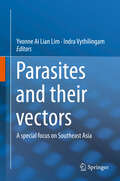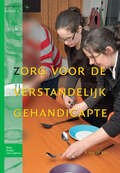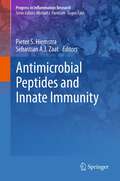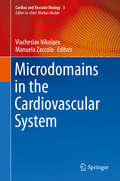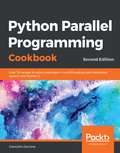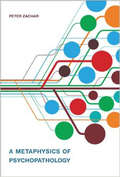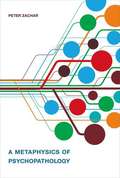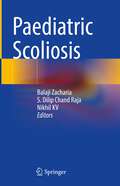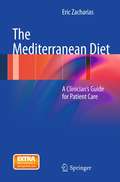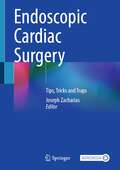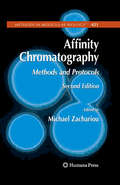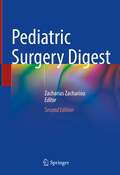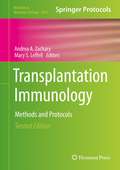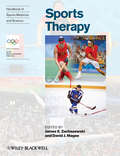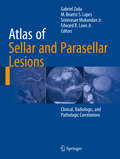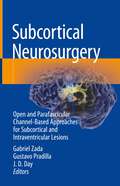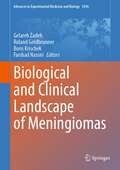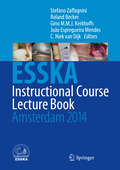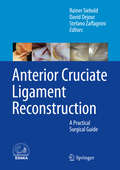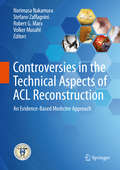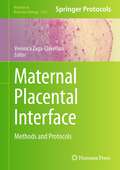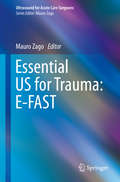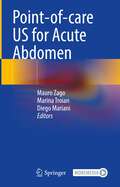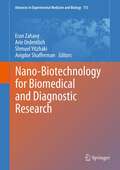- Table View
- List View
Parasites and their vectors
by Yvonne Ai Lian Lim Indra VythilingamSoutheast Asia is a region where a myriad of infections are endemic. It is a hotspot region for parasitic diseases. Currently, information on parasitic infections and vectors found in Southeast Asia is sporadic and there has been no attempt to extensively collate and integrate these data. Gaps in our knowledge, which include disease patterns, transmission dynamics and vectors still exist. This book highlights parasitic diseases that are peculiar to Southeast Asia, pinpoints similarities and differences between disease patterns in the respective member countries and provide information on new emerging parasitic diseases in this region. Critically, this book will heighten understanding of parasitic diseases and their vectors in this diverse region and this knowledge will be significant for future regional research efforts in this field.
Zorg voor de verstandelijk gehandicapte: Basiswerken verpleging en verzorging
by Yvonne van de VenBehandelt de meest voorkomende onderwerpen en begrippen.<P><P> Koppelt de theorie aan de praktijk door middel van casussen.<P> Behandelt naast de beperkingen ook de mogelijkheden tot ondersteuning.<P> Gaat verder dan de basisprincipes.<P> Zorg voor de verstandelijke gehandicapte laat zien hoe veelzijdig begeleiding aan mensen met een verstandelijke beperking is. Alle onderwerpen en begrippen die regelmatig voorkomen in deze zorg, komen aan bod. Om de theorie dicht bij de praktijk te brengen, is deze gekoppeld aan een casus. Dat maakt het boek aansprekend en goed leesbaar. Ook onderwerpen als wetgeving en kwaliteit blijven op deze manier dicht bij het werk van de verzorgende. De ondersteuning aan mensen met een verstandelijke beperking vindt zo veel mogelijk in de maatschappij plaats. Dit vergt van de verzorgende een aanpassing in houding en begeleiding. Het boek behandelt, naast de beperkingen, de mogelijkheden tot ondersteuning. Mensen met een verstandelijke beperking ervaren vaak beperkingen op lichamelijk, psychisch en sociaal gebied. De combinatie hiervan maakt het noodzakelijk om vanuit een breed perspectief naar cliënten te kijken. Het boek maakt duidelijk dat de rol van de verzorgende centraal staat in de multidisciplinaire begeleiding. Om problemen op tijd te signaleren, is observatie op basis van voldoende basiskennis noodzakelijk. Deze kennis biedt dit boek.
Antimicrobial Peptides and Innate Immunity (Progress in Inflammation Research)
by Sebastian A. Zaat Pieter S. HiemstraAntimicrobial peptides have been the subject of intense research in the past decades, and are now considered as an essential part of the defense system in bacteria, plants, animals and humans. his book provides an update on these effector molecules of the innate immune system both for researchers who are already actively involved in the area, and for those with a general interest in the topic. The book starts with an overview of the evolution of cysteine-containing antimicrobial peptides (including defensins), and the role of these peptides in host defense in plants and micro-organisms. The realization that antimicrobial peptides also display functions distinct from their direct antimicrobial action is the focus of the next chapters, and puts these peptides center stage in immunity and wound repair. Further chapters discuss the role of antimicrobial peptides in disease, by providing an overview of mechanisms in bacterial resistance to antimicrobial peptides and a discussion of their role in inflammatory bowel disease, cystic fibrosis lung disease and chronic obstructive pulmonary disease. Finally, the book shows how knowledge of the function of antimicrobial peptides and their regulation can be used to design new therapies for inflammatory and infectious disorders. This is a very important area of research because of the increase in resistance of micro-organisms to conventional antibiotics. Therefore the use of synthetic or recombinant peptides, or agents that stimulate the endogenous production of antimicrobial peptides, provides an attractive alternative for conventional antibiotics.
Microdomains in the Cardiovascular System (Cardiac And Vascular Biology Ser. #4)
by Manuela Zaccolo Viacheslav NikolaevThe book comprehensively presents new findings in cardiovascular research related to signaling microdomains in health and disease. Important second messengers such as cAMP, cGMP, calcium and their role in microdomain signaling are discussed. The book offers and explains methodical approaches and technical ways how to successfully analyze microdomain signaling, also in the context of disease. It further provides scientific perspectives and strategies that are based on the concept of signaling within microdomains and that can revolutionize pharmacology and eventually lead to the effective treatment of cardiovascular diseases in future. This book is written for scientists in cardiovascular research, pharmacology, molecular and cellular biology as well as medical doctors in cardiology, angiology and nephrology.
Python Parallel Programming Cookbook: Over 70 recipes to solve challenges in multithreading and distributed system with Python 3, 2nd Edition
by Giancarlo ZacconeImplement effective programming techniques in Python to build scalable software that saves time and memory Key Features Design distributed computing systems and massive computational tasks coherently Learn practical recipes with concise explanations that address development pain points encountered while coding parallel programs Understand how to host your parallelized applications on the cloud Book Description Nowadays, it has become extremely important for programmers to understand the link between the software and the parallel nature of their hardware so that their programs run efficiently on computer architectures. Applications based on parallel programming are fast, robust, and easily scalable. This updated edition features cutting-edge techniques for building effective concurrent applications in Python 3.7. The book introduces parallel programming architectures and covers the fundamental recipes for thread-based and process-based parallelism. You'll learn about mutex, semaphores, locks, queues exploiting the threading, and multiprocessing modules, all of which are basic tools to build parallel applications. Recipes on MPI programming will help you to synchronize processes using the fundamental message passing techniques with mpi4py. Furthermore, you'll get to grips with asynchronous programming and how to use the power of the GPU with PyCUDA and PyOpenCL frameworks. Finally, you'll explore how to design distributed computing systems with Celery and architect Python apps on the cloud using PythonAnywhere, Docker, and serverless applications. By the end of this book, you will be confident in building concurrent and high-performing applications in Python. What you will learn Synchronize multiple threads and processes to manage parallel tasks Use message passing techniques to establish communication between processes to build parallel applications Program your own GPU cards to address complex problems Manage computing entities to execute distributed computational task Write efficient programs by adopting the event-driven programming model Explore cloud technology with Django and Google App Engine Apply parallel programming techniques that can lead to performance improvements Who this book is for The Python Parallel Programming Cookbook is for software developers who are well-versed with Python and want to use parallel programming techniques to write powerful and efficient code. This book will help you master the basics and the advanced of parallel computing.
A Metaphysics of Psychopathology (Philosophical Psychopathology)
by Peter ZacharAn exploration of what it means to think about psychiatric disorders as “real,” “true,” and “objective” and the implications for classification and diagnosis.In psychiatry, few question the legitimacy of asking whether a given psychiatric disorder is real; similarly, in psychology, scholars debate the reality of such theoretical entities as general intelligence, superegos, and personality traits. And yet in both disciplines, little thought is given to what is meant by the rather abstract philosophical concept of “real.” Indeed, certain psychiatric disorders have passed from real to imaginary (as in the case of multiple personality disorder) and from imaginary to real (as in the case of post-traumatic stress disorder). In this book, Peter Zachar considers such terms as “real” and “reality”—invoked in psychiatry but often obscure and remote from their instances—as abstract philosophical concepts. He then examines the implications of his approach for psychiatric classification and psychopathology.Proposing what he calls a scientifically inspired pragmatism, Zachar considers such topics as the essentialist bias, diagnostic literalism, and the concepts of natural kind and social construct. Turning explicitly to psychiatric topics, he proposes a new model for the domain of psychiatric disorders, the imperfect community model, which avoids both relativism and essentialism. He uses this model to understand such recent controversies as the attempt to eliminate narcissistic personality disorder from the DSM-5. Returning to such concepts as real, true, and objective, Zachar argues that not only should we use these metaphysical concepts to think philosophically about other concepts, we should think philosophically about them.
A Metaphysics of Psychopathology
by Peter ZacharIn psychiatry, few question the legitimacy of asking whether a given psychiatric disorder is real; similarly, in psychology, scholars debate the reality of such theoretical entities as general intelligence, superegos, and personality traits. And yet in both disciplines, little thought is given to what is meant by the rather abstract philosophical concept of "real." Indeed, certain psychiatric disorders have passed from real to imaginary (as in the case of multiple personality disorder) and from imaginary to real (as in the case of post-traumatic stress disorder). In this book, Peter Zachar considers such terms as "real" and "reality" -- invoked in psychiatry but often obscure and remote from their instances -- as abstract philosophical concepts. He then examines the implications of his approach for psychiatric classification and psychopathology. Proposing what he calls a scientifically inspired pragmatism, Zachar considers such topics as the essentialist bias, diagnostic literalism, and the concepts of natural kind and social construct. Turning explicitly to psychiatric topics, he proposes a new model for the domain of psychiatric disorders, the imperfect community model, which avoids both relativism and essentialism. He uses this model to understand such recent controversies as the attempt to eliminate narcissistic personality disorder from the DSM-5. Returning to such concepts as real, true, and objective, Zachar argues that not only should we use these metaphysical concepts to think philosophically about other concepts, we should think philosophically about them.
Paediatric Scoliosis
by Balaji Zacharia S. Dilip Chand Raja Nikhil KvThe understanding of Pediatric scoliosis has evolved over decades of research, and significant advancements have been achieved in managing the multiple types of scoliotic deformities. This book provides comprehensive information on etiopathogenesis, evaluation, and management of scoliosis along with the latest technological advances. This book is also an invaluable and practical tool providing critical information on the rationale behind the several classification systems of scoliosis. This book, authored by reputed Indian Spine surgeons and renowned international scoliosis experts, focuses on the current treatment algorithms based on the etiology and natural history of the disease and simplifies the decision-making process in managing scoliosis in children. We have included sections that describe various corrective maneuvers, surgical techniques, expected complications, and tips and tricks to avoid them. This book will serve as an essential guide for all orthopedic and neurosurgery trainees and residents and provides updates for experienced surgeons on recent advancements in surgical techniques.
The Mediterranean Diet
by Eric ZachariasOver the past several years there has been increasing information in the medical literature regarding the health benefits of a Mediterranean diet. Clinicians may not be informed on advances in nutrition, and studies have demonstrated that they do not spend much time discussing food as a means for promoting health with patients. The Mediterranean Diet: A Clinician's Guide for Patient Care is an essential new volume that serves as an update and a reference for clinicians on the Mediterranean diet. Specific diseases and the effects the Mediterranean diet have on them are outlined. Diseases and conditions that are outlined include heart disease, stroke, Alzheimer's, depression, cancer, allergies, asthma, arthritis and diabetes. A detailed analysis of the specific nutrients in a Mediterranean diet and the food groups containing them is also included. A useful guide containing daily meal plans and and an extensive recipe section prepared by a team of dieticians can be found in the patient resources section. The Mediterranean Diet: A Clinician's Guide for Patient Care provides a useful summary of the constituent components and health benefits of a Mediterranean diet to health professionals.
Endoscopic Cardiac Surgery: Tips, Tricks and Traps
by Joseph ZachariasThis book is unique in describing the practical considerations of endoscopic cardiac surgery. It covers this topic from basic concepts such as patient selection to imaging and outlines the different approaches to particular endoscopic cardiac surgical procedures. As there is an increasing acceptance that cardiac surgery needs to be provided to older and sicker patients and more asymptomatic patients, the option of a sternotomy is becoming less appealing. The endoscope has changed the patient pathway in many surgical specialities, but until recently cardiac surgery has been slow to adopt this approach. With improvements in imaging and better imaging technology, there is a steady increase in accepted procedures and trained surgeons offering this approach. Endoscopic Cardiac Surgery: Tips, Tricks and Traps captures the experience of endoscopic cardiac surgeons from around the world and is a concise yet thorough reference book for those starting a program in this discipline. With over 3 hours of associated video material, it will be an essential primer for the discipline, therefore making it a valuable reference for trainees in cardiac surgery and experienced surgeons wishing to add this approach to their armamentarium. Via app: download the SN More Media app for free, scan a link with play button and access MP4 directly on your smartphone or tablet.
Affinity Chromatography: Methods and Protocols (Methods in Molecular Biology #421)
by Michael ZachariouThirty-eight years after its introduction, affinity chromatography remains a key tool in the armory of separation techniques available to separation and interaction scientists. Expanded and updated from the first edition, this second edition volume aims to provide the beginner with the practical knowledge needed to develop affinity separations suitable for a variety of applications relevant to the post-genomic era. It contains state-of-the-art, brand new protocols, and provides step-by-step laboratory instructions for readily reproducible results.
Pediatric Surgery Digest
by Zacharias ZachariouThis concise digest offers a practically oriented and up-to-date overview of all subjects in pediatric surgery according to the European surgical curriculum. Additionally, interdisciplinary aspects concerning pediatrics, adult surgery, obstetrics and other disciplines working with children are considered. The tables enable quick access to indications for the operative and conservative therapy with schematic step-by-step illustrations for nearly all surgical procedures.
Transplantation Immunology
by Andrea A. Zachary Mary S. LeffellAfter decades of research in clinical transplantation, new techniques have been developed that permit a further understanding of the immune mechanisms underlying immune recognition of allografts and a more accurate and thorough evaluation of compatibility between donors and recipients. The second edition of Transplantation Immunology: Methods and Protocols expands upon the previous edition with current, detailed methods in transplantation immunology. The new methods chapters cover four major areas that are being applied in compatibility evaluations and ongoing transplantation immunology research. Seven overview chapters provide reviews of the molecular basis for alloreactivity, current understanding of humoral and cellular mechanisms, as well as new developments in thoracic organ transplantation, composite tissue transplantation and in the transplantation of sensitized patients. Written in the highly successful Methods in Molecular BiologyTM series format, chapters include introductions to their respective topics, lists of the necessary materials and reagents, step-by-step, readily reproducible laboratory protocols, and key tips on troubleshooting and avoiding known pitfalls. Authoritative and practical, Transplantation Immunology: Methods and Protocol, Second Edition is devoted to transplantation immunology, both in the practice of compatibility testing and in transplantation research.
Handbook of Sports Medicine and Science, Sports Therapy: Organization and Operations
by James E. Zachazewski David J. MageeHandbook of Sports Therapy Services: Organization and Operations is a practical guide, appropriate for each member of the multi-disciplinary "Sports Therapy" team, to establishing and effectively delivering the diverse therapy services required for athletes at international, national, and regional sporting events.
Unfälle durch Blitzschlag: Medizinische Aspekte
by Fred ZackDas Buch stellt die relevanten medizinischen Aspekte bei einem Unfall durch Blitzschlag praxisnah und mit Fallbeispielen belegt dar: Arten der Energieübertragung, meteorologische und elektrotechnische Grundlagen, notfallmedizinische Erstversorgung sowie Überblick über die häufigsten, in der internationalen Literatur beschriebenen Folgeerkrankungen und deren Behandlung. Weitere Themen sind die Besonderheiten der ärztlichen Leichenschau bei Tod durch Blitzschlag, pathophysiologische Aspekte der Todesursache sowie Wissenswertes zur Epidemiologie. Es wendet sich an Ärzte und Ärztinnen aller Fachdisziplinen, die in die Akutversorgung oder Nachsorge von Personen nach Unfällen durch Blitzschlag eingebunden sind, z.B. aus der Notfallmedizin, Rechtsmedizin, Intensivmedizin und Allgemeinmedizin.
Atlas of Sellar and Parasellar Lesions: Clinical, Radiologic, and Pathologic Correlations
by Gabriel Zada M. Beatriz S. Lopes Srinivasan Mukundan Jr. Edward R. Laws Jr.This book presents, in a stepwise and interactive fashion, approximately 75 cases that reflect the wide spectrum of pathology encountered in this region. Each case description commences with a concise clinical scenario. High-quality radiologic, laboratory, and histopathologic images depicting the differentiating features of the lesion subtype in question are then presented, and key operative and clinical management pearls are briefly reviewed. The interdisciplinary nature of this easy-to-use color atlas and textbook reflects the fact that the management of patients with sellar and parasellar lesions is itself often interdisciplinary. The format is unique in that no similar interdisciplinary book is available on lesions of this region of the brain. Atlas of Sellar and Parasellar Lesions: Clinical, Imaging, and Pathologic Correlations is of great value for practitioners and trainees in a range of medical specialties, including radiology, neurology, endocriniology, pathology, oncology, radiation oncology, and neurosurgery.
Subcortical Neurosurgery: Open and Parafascicular Channel-Based Approaches for Subcortical and Intraventricular Lesions
by Gabriel Zada Gustavo Pradilla J. D. DayOur understanding of human neuro-anatomy, and ability to safely access lesions in complex locations, are in continuous evolution. The subcortical white matter space is among the most intricate, yet least understood, regions of the brain, with regards to its billions of connections and the subtle clinical and clinical functions it subserves. Neurosurgical procedures in the subcortical space and intraventricular system have been traditionally very difficult due to their depth, the need for brain retraction, and limited understanding and imaging capability of this region. Common lesions encountered in the subcortical space include brain metastases, gliomas, and intracerebral hemorrhage. Surgical access to this region has classically been hindered, and is highly limited by evolving technological applications to medicine and surgery. Traditionally, the technology (optics, imaging, resection devices, illumination) needed to perform safe subcortical surgery was not commensurate with the surgeon’s needs. Over the past decade, major strides in our ability to image, navigate, and safely access subcortical tumors and other lesions have been made. These include parafascicular, trans-sulcal approaches that may be channel-based to provide safe retraction of the cortical and subcortical matter. A confluence of optical, computational and mechanical technology have greatly enabled our ability to treat such lesions, and include advanced MR imaging such as diffusion tractography, neuronavigation, channel-based access ports, exoscopic visualization, fiber-optic illumination, and novel resection devices.Parafascicular, channel-based subcortical surgery is a relatively new field with evolving indications and approaches that promises to evolve considerably over the next several decades. We aim to develop the first comprehensive reference text compiling the known evidence and experience from expert practitioners in the field of subcortical parafascicular surgery. This book will provide a major foundation for future development of the field, and be a first and definitive reference for decades to come.Subcortical Neurosurgery: Open and Parafascicular Channel-Based Approaches for Subcortical and Intraventricular Lesions will be the definitive reference on surgery of the subcortical region. It will comprehensively discuss all aspects of treatment of subcortical and intraventricular lesions, including neuroanatomy and neuroimaging of the subcortical space, principles of parafascicular subcortical channel-based surgery, common indications and approaches, and focused chapters for common subcortical lesions. The first section of the reference focuses on the intricate anatomy and neuro-imaging of the subcortical space and ventricular system, with special emphasis on intricate white matter tracts and diffusion tractography imaging. The next section of the book discusses principles of both open and parafascicular, channel-based approaches to subcortical and intraventricular lesions, in addition to workhorse approaches to common subcortical compartments. Finally, specific pathological subcortical lesions that can be commonly addressed via parafascicular channel-based approaches, including brain metastases, gliomas, and intracerebral hemorrhage will be addressed. Authored by experts in the field of subcortical neurosurgery, this book was developed to provide a unique, comprehensive text for neurosurgeons, neuro-radiologists, and trainees from a variety of specialties interested in evolving minimally disruptive access and treatment of the subcortical space.
Biological and Clinical Landscape of Meningiomas (Advances in Experimental Medicine and Biology #1416)
by Gelareh Zadeh Roland Goldbrunner Boris Krischek Farshad Nassiri"Meningiomas are tumors that originate from the arachnoidal cap cells of the leptomeninges. With an incidence rate of 8.36 per 100, 000 population, they are the most common primary central nervous system (CNS) tumors, accounting for a third of all cases. The World Health Organization (WHO) classification has traditionally categorized meningiomas into 15 different histopathological subtypes and three clinical grades. Tumors are classified as WHO grades 1, 2 or 3 based largely on histopathological features such as mitotic activity, presence of brain invasion, and other atypical features. However, there is increasing recognition of the limitations of histopathology including but not limited to: confounding factors such as sampling bias in a heterogeneous tumor, and technical factors related to the experience of the grading pathologist. Even with careful histologic grading, there remains significant variability in recurrence rates within each tumor grade. As more studies have uncovered the molecular features of meningiomas, novel biological alterations have helped refine classification schemes that more accurately reflect patient outcomes. This book reviews the current state of knowledge on the genomic and epigenomic landscape of meningiomas in order to identify the roles of genomic aberrations on diagnosis, prognosis, and treatment of meningiomas in addition to mainstays of surgical management, radiation therapy, and potential novel chemotherapies. Written by a team of world-renowned experts in neurosurgery, neuropathology, radiology, and radiation-oncology, this book is the definitive resource on meningioma management and investigation for both clinicians and scientists alike."
ESSKA Instructional Course Lecture Book
by Stefano Zaffagnini Roland Becker Gino M.M.J. Kerkhoffs João Espregueira Mendes C. Niek DijkThis book provides an update on a wide variety of hot topics in the field of knee surgery, sports trauma and arthroscopy, covering the latest developments in basic science and clinical and surgical methods. It comprises the Instructional Course Lectures delivered at the 16th ESSKA Congress, which was held in Amsterdam during May 2014 and brought together the world's leading orthopaedic and sports physicians. The contributions are all written by European and international experts in their field. Each lecture has a practical focus and provides an up-to-date synthesis of core knowledge on the subject in question with the aid of high-quality illustrations. Take home messages and key recommendations are highlighted. This book will be of value to practitioners and researchers alike.
Anterior Cruciate Ligament Reconstruction: A Practical Surgical Guide
by Stefano Zaffagnini David Dejour Rainer SieboldThis practical and instructional guidebook, written by international experts in anterior cruciate ligament (ACL) reconstruction, covers all challenging aspects of ACL rupture in the acute and chronic setting. It covers the latest, spectacular anatomical findings, treatment of partial ACL tears, various techniques for single- and double-bundle ACL reconstruction, and complex ACL revision surgery. Important surgical steps are clearly described with the help of instructive, high-quality photographs. Important tips, tricks, and pitfalls are highlighted and intra- and postoperative complications, rehabilitation, and prevention of re-rupture are discussed. All authors are prominent and experienced ACL surgeons.
Controversies in the Technical Aspects of ACL Reconstruction: An Evidence-Based Medicine Approach
by Stefano Zaffagnini Robert G. Marx Norimasa Nakamura Volker MusahlThis book provides the reader with the best available evidence on the most pressing issues relating to reconstruction of the anterior cruciate ligament (ACL) with the goal of supporting surgical reconstruction of the ACL and improving outcomes for patients. Key topics for which evidence-based information is presented include selection of graft material and source, the use of different surgical techniques, graft rupture in relation to surgical technique, and progression to osteoarthritis. The book will aid the surgeon in making decisions with respect to fixation devices and tensioning, the bundles to be reconstructed, and whether to preserve remnants or partial bundle ruptures. An evidence-based stance is taken on evolving topics such as the anatomy of the tibial insertion site of the ACL and the role of the anterolateral capsule and posteromedial corner in high-grade rotatory instability. Furthermore, novel technical developments for measurement of knee laxity and soft tissue navigation are discussed. The reader will also find useful information on general issues concerning physical examination, arthroscopic setup, timing of reconstruction, anesthesia, and anticoagulation.
Maternal Placental Interface: Methods and Protocols (Methods in Molecular Biology #2781)
by Verónica Zaga-ClavellinaThis volume details critical and valuable experimental protocols to facilitate researchers in this fascinating field. Written in the highly successful Methods in Molecular Biology series format, chapters include introductions to their respective topics, lists of the necessary materials and reagents, step-by-step, readily reproducible laboratory protocols, and key tips on troubleshooting and avoiding known pitfalls. Authoritative and cutting-edge, Maternal Placental Interface: Methods and Protocols aims to ensure successful results in the further study of this vital field.
Essential US for Trauma: E-FAST
by Mauro ZagoE-FAST (extended focused assessment by sonograpy for trauma) represents the basic ultrasonographic approach to any trauma patient. Identification or exclusion of free fluid and air in the abdominal and thoracic cavities plays a pivotal role in deciding the immediate diagnostic and therapeutic path. Learning E-FAST is mandatory for all acute care surgeons and all physicians involved in trauma management. The structure of the book and its practical approach will make it an easy-to-consult and quick reference tool for beginners and a useful support for more experienced professionals.
Point-of-care US for Acute Abdomen
by Mauro Zago Marina Troian Diego MarianiThis book focuses on surgical decision-making, a key topic for both surgeons and emergency physicians who are faced with patients with acute abdominal pain. Providing easy-to-understand technical details and discussing the interpretation of normal and pathological images, it is a valuable resource for surgeons and emergency physicians who are not used to applying clinical US in this field, enabling them to shorten the diagnostic path and avoid unnecessary costs and exposure to radiation. It is also a practical reference guide for surgeons and doctors wanting to apply US as a decision-making tool in the context of acute abdominal pain.
Nano-Biotechnology for Biomedical and Diagnostic Research
by Eran Zahavy Arie Ordentlich Shmuel Yitzhaki Avigdor ShaffermanThe title "Nano Biotechnology for Biomedical and Diagnostics Research" will address research aspects related to nanomaterial in imaging and biological research, nanomaterials as a biosensing tool, DNA nanotechnology, nanomaterials for drug delivery, medicinal and therapeutic application and cytotoxicity of nanomaterials. These topics will be covered by 16 different manuscripts. Amongst the authors that will contribute to the book are major scientific leaders such as S. Weiss - UCLA, I. Willner, and G. Golomb - HUJI, S. Esener - UCSD, E.C. Simmel - Tech. Univ. Munchen, I. Medintz - NRL, N. Hildebrandt - Université Paris and more. The manuscripts in the book intend to present specifically biological, diagnostics and medical problems with their potential solution by nano technology or materials. In this respect this book is unique, since it would arise from the biological problems to the nano technology possible solution and not vice versa.
